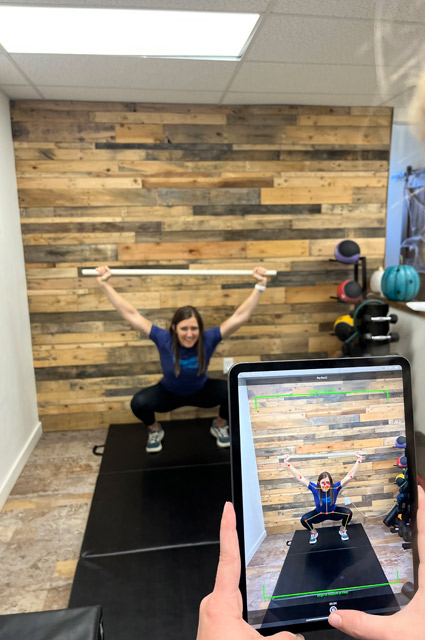 While we often associate squats with exercise, a squat is a common full body movement used in daily activity. No matter your age, you perform a squat multiple times daily.
While we often associate squats with exercise, a squat is a common full body movement used in daily activity. No matter your age, you perform a squat multiple times daily.
Besides being a fundamental movement pattern, a squat gives tremendous insight into your potential risk for injury and pain. Improper movement patterns in squat mechanics can eventually lead to low back injury, among other problems.
While the primary cause for most injuries is overuse, the second most common reason for injury is the body compensating with altered movement patterns. Knowing how your squat measures with an Overhead Squat Assessment (OHSA) is a great place to start to prevent and address a variety of pain and movement issues.
How Do I Learn About My Squat?
The best way to learn if you have any muscle imbalances that might contribute to movement issues and related pain is by undergoing an Overhead Squat Assessment (OHSA) with a Corrective Exercise Specialist.
A Corrective Exercise Specialist has extensive training in human movement and an understanding in how to properly analyze your movement patterns. Using the OHSA, a CES can identify muscle imbalances that are contributing to your less-than-ideal movement patterns and pinpoint any overactive and underactive muscle groups. Your specific compensations can also be explained from this valuable information.
In addition to helping you understand the results of your squat assessment, our Corrective Exercise Specialist will break down what an ideal movement pattern should be and help you uncover any factors from your lifestyle or work that may contribute to your specific compensations.
Can I Change My Squat?
The answer is yes! With the knowledge of where your body has muscle imbalances and the tools to correct them, your Corrective Exercise Specialist will design a customized program for you. Your program will be based on the movement patterns that present in your squat assessment while keeping your goals in mind.
The process for corrective exercise is research-based, highly effective, and our patients have had incredible results. The corrective exercise strategy involves adding flexibility to your overactive muscles, teaching your body to use underactive muscles, and ensures your muscles work together efficiently using complex exercises.
The Corrective Exercise Specialists at Denton Sports Chiropractic work alongside our chiropractors to create a detailed and progressive exercise program to strategically address your specific muscle imbalances. As you become stronger and more balanced, your body’s ability to maintain proper movement patterns during a squat and other daily activities significantly increases. Our patients have also reported less pain and increased awareness of their body positions.
What Conditions Can Be Helped?
At Denton Sports Chiropractic, our patients have had powerful and lasting results by incorporating corrective exercise into their treatment plans. Many reach their goals quickly and choose to continue with corrective exercise to focus on additional needs.
Our patients have had success using the OHSA and corrective exercise to reach goals in the following areas:
- Sports performance
- Neck pain
- Low back pain
- SI joint pain
- Hip flexor pain
- Ankle stability & mobility issues
- Cervical spine injury
- Core stability
- Core strength
- Plantar fasciitis
- Knee pain
- Balance training
- Diaphragmatic breathing
- Shoulder impingement & mobility issues
Ready to learn what your squat reveals about your movement and risk for injury? Book an evaluation with a Corrective Exercise Specialist, and we will educate you while helping you achieve your goals faster.
